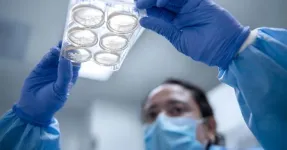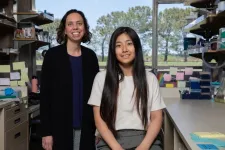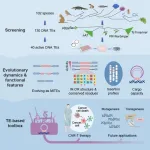(Press-News.org) Some children with autism experience profound, lifelong difficulties like developmental delay, social struggles and even the inability to speak. Others experience more mild symptoms that improve with time.
The disparity in outcomes has been a mystery to scientists, until now. A new study, published in Molecular Autism by researchers at University of California San Diego, is the first to shed light on the matter. Among its findings: The biological basis for these two subtypes of autism develops in utero.
Researchers used blood-based stem cells from 10 toddlers, ages 1 through 4, with idiopathic autism (in which no single-gene cause was identified) to create brain cortical organoids (BCOs), or models of the fetal cortex. They also created BCOs from six neurotypical toddlers.
Often referred to as gray matter, the cortex lines the outside of the brain. It holds tens of billions of nerve cells and is responsible for essential functions like consciousness, thinking, reasoning, learning, memory, emotions and sensory functions.
Among their findings: The BCOs of toddlers with autism were significantly larger — roughly 40 percent — than those of neurotypical controls, according to two rounds of study performed in different years (2021 and 2022). Each round involved the creation of hundreds of organoids from each patient.
The researchers also found that abnormal BCO growth in toddlers with autism correlated with their disease presentation. The larger a toddler’s BCO size, the more severe their social and language symptoms were later in life, and the larger their brain structure on MRI. Toddlers with excessively enlarged BCOs showed greater-than-typical volume in social, language and sensory brain areas when compared to neurotypical peers.
“The bigger the brain, the better isn’t necessarily true,” said Alysson Muotri, Ph.D., director of the Sanford Stem Cell Institute (SSCI) Integrated Space Stem Cell Orbital Research Center at the university. The SSCI is directed by Catriona Jamieson, M.D., Ph.D., a leading physician-scientist in cancer stem cell biology whose research explores the fundamental question of how space alters cancer progression.
“We found that in the brain organoids from toddlers with profound autism, there are more cells and sometimes more neurons — and that’s not always for the best,” added Muotri, who is also a professor in the Departments of Pediatrics and Cellular and Molecular Medicine at the UC San Diego School of Medicine.
What’s more, the BCOs of all children with autism, regardless of severity, grew roughly three times faster than those of neurotypical children. Some of the largest brain organoids — from children with the most severe, persistent cases of autism — also saw the accelerated formation of neurons. The more severe a toddler’s autism, the quicker their BCO grew — sometimes to the point of developing an excess of neurons.
Eric Courchesne, Ph.D., a professor in the School of Medicine’s Department of Neurosciences who co-led the research with Muotri, called the study “one of a kind.” Matching data on children with autism — including their IQs, symptom severity and imaging like MRIs — with their corresponding BCOs or similar stem cell-derived models makes an incredible amount of sense, he said. But oddly enough, such research hadn’t been undertaken ahead of their work.
“The core symptoms of autism are social affective and communication problems,” said Courchesne, who also serves as co-director of the UC San Diego Autism Center of Excellence. “We need to understand the underlying neurobiological causes of those challenges and when they begin. We are the first to design an autism stem cell study of this specific and central question.”
It’s long been assumed that autism, a complex pool of progressive disorders, begins prenatally and involves multiple stages and processes. While no two people with autism are like — just as no two neurotypical people are — those with the neurodevelopmental condition can generally be grouped into two categories: those who have severe social struggles and require lifelong care, and may even be nonverbal, and those who have a milder version of the condition who eventually develop good language skills and social relationships.
Scientists haven’t been able to ascertain why at least two groups of individuals with autism exist. They also haven’t been able to prenatally identify children with autism, let alone predict how severe their condition might be.
Now that Courchesne and Muotri have established that brain overgrowth begins in the womb, they hope to pinpoint its cause, in a bid to develop a therapy that might ease intellectual and social functioning for those with the condition.
Co-authors of the study include Vani Taluja, Sanaz Nazari, Caitlin M. Aamodt, Karen Pierce, Kuaikuai Duan, Sunny Stophaeros, Linda Lopez, Cynthia Carter Barnes, Jaden Troxel, Kathleen Campbell, Tianyun Wang, Kendra Hoekzema, Evan E. Eichler, Joao V. Nani, Wirla Pontes, Sandra Sanchez Sanchez, Michael V. Lombardo and Janaina S. de Souza.
This work was supported by grants from the National Institute of Deafness and Communication Disorders, the National Institutes of Health, the California Institute for Regenerative Medicine and the Hartwell Foundation. We thank the parents of the toddlers in San Diego whose stem cells were reprogrammed to BCOs.
# # #
About the Sanford Stem Cell Institute
The UC San Diego Sanford Stem Cell Institute (SSCI) is a global leader in regenerative medicine and a hub for stem cell science and innovation in space. SSCI aims to catalyze critical basic research discoveries, translational advances and clinical progress — terrestrially and in space — to develop and deliver novel therapeutics to patients.
About the UC San Diego Autism Center of Excellence
The UC San Diego Autism Center of Excellence is a world leader in autism research. It has made pioneering discoveries that enable early detection and treatment of autism in infants and toddlers through innovative behavior and eye tracking tests. The center’s groundbreaking discoveries on the developmental neurobiology of autism have led to fundamental knowledge of the molecular, cellular and brain growth and function causes of autism
END
Brain overgrowth dictates autism severity, new research suggests
An unusually large brain may be the first sign of autism — and visible as early as the first trimester, University of California San Diego researchers found
2024-06-05
ELSE PRESS RELEASES FROM THIS DATE:
MD Anderson Research Highlights for June 5, 2024
2024-06-05
HOUSTON ― The University of Texas MD Anderson Cancer Center’s Research Highlights showcases the latest breakthroughs in cancer care, research and prevention. These advances are made possible through seamless collaboration between MD Anderson’s world-leading clinicians and scientists, bringing discoveries from the lab to the clinic and back.
Recent developments at MD Anderson offer insights into a lower-intensity therapy combination for older patients with acute myeloid leukemia (AML), a novel T cell therapy for patients with bone marrow failure syndromes, a proof-of-concept study using MRI to detect metabolic changes inside tumors, a molecular target to overcome treatment resistance ...
New study finds many of the world’s most threatened species lack evidence of sufficient conservation efforts
2024-06-05
-With images-
A new study has revealed alarming gaps in the implementation of conservation interventions for thousands of the world's most threatened species.
The research, published in the journal Nature, shows that most terrestrial plant and animal species at risk of extinction from threats like habitat loss, over-exploitation for trade, and invasive species are not receiving the appropriate types of conservation efforts needed to protect them.
The study findings suggest that there is a serious mismatch between the ...
BU study: Black-specific incarceration rates are associated with Black firearm homicide rates
2024-06-05
(Boston)—Firearm-related injury remains a significant burden in the U.S. with more than 45,000 people dying from these injuries in 2020. Suicides continue to account for the majority of all gun deaths. The number of homicides due to gun violence decreased between 1990 and 2010, but the last decade has seen an uptick. Homicides now make up 45% of all gun-related deaths, and Black and other minorities are overrepresented among firearm homicide victims. Moreover, there has been a stark increase in incarcerated populations in the U.S since the 1980s largely due to differential drug sentencing, ...
New technique reveals how gene transcription is coordinated in cells
2024-06-05
The human genome contains about 23,000 genes, but only a fraction of those genes are turned on inside a cell at any given time. The complex network of regulatory elements that controls gene expression includes regions of the genome called enhancers, which are often located far from the genes that they regulate.
This distance can make it difficult to map the complex interactions between genes and enhancers. To overcome that, MIT researchers have invented a new technique that allows them to observe the timing of gene and enhancer activation in a cell. When a gene is turned on around the same time as a particular enhancer, it strongly suggests the enhancer ...
Major cause of inflammatory bowel disease discovered
2024-06-05
Researchers at the Francis Crick Institute, working with UCL and Imperial College London, have discovered a new biological pathway that is a principal driver of inflammatory bowel disease (IBD) and related conditions, and which can be targeted using existing drugs.
About 5% of the world’s population, and one in ten people in the UK1, are currently affected by an autoimmune disease, such as IBD, the umbrella term for Crohn’s disease and ulcerative colitis. These diseases are also becoming more common, with over half a million people living with IBD in the UK as of 2022, nearly double the 300,000 previously estimated2.
Despite increasing prevalence, current treatments do not ...
Cooperative proteins help the immune system identify and attack invaders
2024-06-05
LA JOLLA (June 5, 2024)—Bacteria, parasites, viruses—the immune system tackles them all. At the front line of the human immune response are cells called macrophages, which are responsible for correctly identifying intruders and then directing how the entire immune system responds. Researchers at the Salk Institute have now discovered a molecular mechanism that helps macrophages mount a coordinated response tailored to a specific immune challenge.
Activating macrophages requires the work of three versions of a protein complex called SWI/SNF: cBAF, ncBAF, and PBAF. Scientists already knew these variants had slightly different structures, but ...
Why do 1 in 10 Americans get eczema? Is it too much salt?
2024-06-05
Why Do 1 in 10 Americans Get Eczema? Is it Too Much Salt?
UCSF Study finds that changes in daily salt intake may explain eczema flares.
A high sodium diet may increase the risk of eczema, according to researchers at UC San Francisco (UCSF), who found that eating just one extra gram of sodium per day – the amount in a Big Mac – increases the likelihood of flares by 22%.
Eczema, also known as atopic dermatitis, is a chronic disease that causes dry, itchy skin. It’s one of ...
Banning false information traffickers online improved public discourse
2024-06-05
When Twitter banned more than 70,000 traffickers of false information from its platform in the wake of the violence at the U.S. Capitol on Jan. 6, 2021, the impact went beyond the silencing of those users.
A study co-authored by UC Riverside public policy and political science scholars published in the journal Nature on Wednesday, June 5, found that the crackdown by Twitter (now called X after it was acquired by billionaire Elon Musk in late 2022) also significantly reduced the number of misinformation posts by users who stayed on the platform but had been following those who were kicked off.
Additionally, the study found that many of the misinformation ...
Cannabis use common among patients, with most using it to manage a symptom or health condition
2024-06-05
One in six patients in primary care reported cannabis use, with 35% of those using at levels indicating moderate- to high-risk for cannabis use disorder, new UCLA research finds.
The findings, to be published June 5 in JAMA Network Open, suggest that most patients reported using cannabis for symptom management, despite identifying as recreational users, indicating the need for routine cannabis screening. Currently few healthcare systems offer this screening in primary care settings.
“Patients may not tell their primary care providers about their cannabis use, and their doctors ...
Large-scale study reveals functional diversity of DNA transposons and expands genome engineering toolbox
2024-06-05
In a study published in Cell, a research team led by ZHANG Yong'e and WANG Haoyi from the Institute of Zoology of the Chinese Academy of Sciences has characterized the diversity of DNA transposons and expanded the genome engineering toolbox.
"Our systematic and comparative framework complements conventional case studies in elucidating basic biology and strengthening applied biology," said Prof. ZHANG, corresponding author of the study.
Since the first discovery of transposons by Barbara McClintock in the 1940s, scientists ...
LAST 30 PRESS RELEASES:
The Ceramic Society of Japan’s Oxoate Ceramics Research Association launches new international book project
Heart-brain connection: international study reveals the role of the vagus nerve in keeping the heart young
Researchers identify Rb1 as a predictive biomarker for a new therapeutic strategy in some breast cancers
Survey reveals ethical gaps slowing AI adoption in pediatric surgery
Stimulant ADHD medications work differently than thought
AI overestimates how smart people are, according to HSE economists
HSE researchers create genome-wide map of quadruplexes
Scientists boost cell "powerhouses" to burn more calories
Automatic label checking: The missing step in making reliable medical AI
Low daily alcohol intake linked to 50% heightened mouth cancer risk in India
American Meteorological Society announces Rick Spinrad as 2026 President-Elect
Biomass-based carbon capture spotlighted in newly released global climate webinar recording
Illuminating invisible nano pollutants: advanced bioimaging tracks the full journey of emerging nanoscale contaminants in living systems
How does age affect recovery from spinal cord injury?
Novel AI tool offers prognosis for patients with head and neck cancer
Fathers’ microplastic exposure tied to their children’s metabolic problems
Research validates laboratory model for studying high-grade serous ovarian cancer
SIR 2026 delivers transformative breakthroughs in minimally invasive medicine to improve patient care
Stem Cell Reports most downloaded papers of 2025 highlight the breadth and impact of stem cell research
Oxford-led study estimates NHS spends around 3% of its primary and secondary care budget on the health impacts of heat and cold in England
A researcher’s long quest leads to a smart composite breakthrough
Urban wild bees act as “microbial sensors” of city health.
New study finds where you live affects recovery after a hip fracture
Forecasting the impact of fully automated vehicle adoption on US road traffic injuries
Alcohol-related hospitalizations from 2016 to 2022
Semaglutide and hospitalizations in patients with obesity and established cardiovascular disease
Researchers ‘listen in’ to embryo-mother interactions during implantation using a culture system replicating the womb lining
How changing your diet could help save the world
How to make AI truly scalable and reliable for real-time traffic assignment?
Beyond fragmented markets: A new framework for efficient and stable ride-pooling
[Press-News.org] Brain overgrowth dictates autism severity, new research suggestsAn unusually large brain may be the first sign of autism — and visible as early as the first trimester, University of California San Diego researchers found



